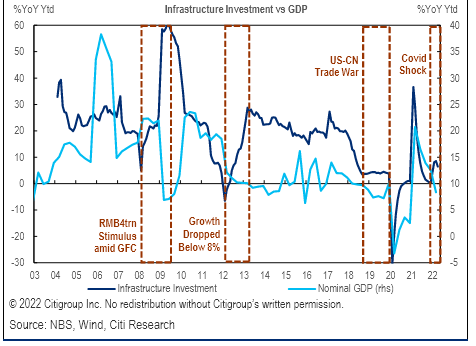
China faces the spectre of missing its annual GDP growth target this year by a wide margin, a first since it began setting targets.
Given the headwinds in consumption, property and exports, infrastructure investment is probably the only driver the Chinese government can count on, according to Citi analysts. On a long view, China remains underdeveloped and unbalanced even in traditional infrastructure. Its industrial upgrading and energy transition can’t be achieved without compatible new and green infrastructure, says Citi.
China still enjoys low labour costs and high efficiency in construction. This presents an opportunity to strengthen the weak links in infrastructure and build the foundation for future development. Pro-investment infrastructure policy actions seem to be real, according to the Citi report.
Infrastructure investment strength in China will hinge on:
[1] replenishment of sizeable fiscal revenue;
[2] effectively pushing (policy) bank & nonbank lending; and
[3] a meaningful recovery in local government financing vehicles (LGFVs) & PPP finance.
Citi expects timely and concrete actions soon to sustain momentum.
Policy execution will also be critical, with downside risks from:
[1] prolonged deep declines in land sales;
[2] over-concerns about implicit local debt risks;
[3] ambiguous political incentives balancing fiscal discipline with growth; and
[4] Covid disruptions.
Mainly driven by the government – and given it can be lifted within a short period, especially compared with sticky consumption – infrastructure spending is often used as a countercyclical tool in China.
The past two decades saw two policy-driven super cycles and one mini cycle of infrastructure investment in China

In 2008-09, the government launched a “RMB4trn” stimulus in response to the global financial crisis, with infrastructure investment as a key focus.
As LGFVs took off, infrastructure investment surged >60%YoY in mid-2009. In 2012-13, China started another round of expansion as GDP growth started to drop below 8% on the back of the earlier tightening on local borrowings. Partly fuelled by shadow finance, infrastructure investment soared as high as 30%YoY in early 2013. In 2018-19, the government again looked to it to offset the pressures from the US-China trade tensions but was not ready to unwind the deleveraging efforts.
Amid the Omicron waves, the recovery road for consumption, especially consumer services, will likely be bumpy ahead, Citi analysts say. And they add that the strong performance of exports may struggle to sustain as competing production bases reopen. To some extent, infrastructure investment becomes the only key driver for aggregate demand the government can count on this year, says the Citi report.
As early as September 2021, Vice Premier Liu He started to change the policy guidance amid the property downturn, suggesting to “appropriately advance infrastructure investment”. The Central Economic Work Conference and the NPC as well as the recent Politburo meeting all further reiterated the pledge to step up infrastructure investing. Moreover, on April 26, President Xi chaired the 11th meeting of the Central Committee for Financial and Economic Affairs (CFEA) and called for “all-out efforts to build a modern infrastructure system”, deeming China’s infrastructure still incompatible with the demand for national development and security
China’s industrial upgrade can only be achieved with compatible new infrastructure, say the Citi analysts. The purpose of infrastructure changes as the economic structure shifts. Just as traditional infrastructure investment has supported China’s emergence as a global manufacturing centre, so new infrastructure will likely be the foundation for its technological & structural upgrading. For more information on this subject, please see China Economics / FX & Rates / Equity View - Infrastructure: Renewed Push as Macro Slips
Citi Global Insights (CGI) is Citi’s premier non-independent thought leadership curation. It is not investment research; however, it may contain thematic content previously expressed in an Independent Research report. For the full CGI disclosure, click here.